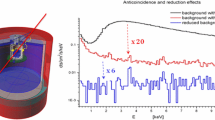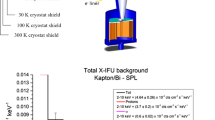Abstract
ATHENA+ is a space mission proposal for the next ESA L2-L3 slot. One of the focal plane instruments is the X-ray integral field unit (X-IFU) working in the energy range 0.3–10 keV. It is a multi-array based on TES detectors aimed at characterizing faint or diffuse sources (e.g. WHIM or galaxy outskirt). The X-IFU will be able to achieve the required sensitivity if a low background is guaranteed. The studies performed by GEANT4 simulations depict a scenario where the use of an active anticoincidence (AC) is mandatory to reduce the background expected in L2 orbit down to the goal level of 0.005 cts cm\(^{-2}\) s\(^{-1}\) keV\(^{-1}\). This is possible using a cryogenic anticoincidence (CryoAC) detector placed within a proper optimized environment surrounding the X-IFU. We propose a 2 \(\times \) 2 array of microcalorimeter detectors made by silicon absorber (each of about 1 cm\(^{2}\) and 300 \(\upmu \)m thick) and sensed by an Ir TES. In order to better understand the involved physics and optimize the performance, we have produced several samples featured by different absorber areas, TES size, and QPs Al collectors. Here we will discuss, as a review, the obtained results and the related impact to the final detector design.






Similar content being viewed by others
References
http://athena2013.irap.omp.eu/WP/The_Hot_and_Energetic_Universe.pdf. Accessed 10 Mar 2014
http://athena2.irap.omp.eu/IMG/pdf/SP_XIFU_APH.pdf. Accessed 10 Mar 2014
S. Lotti et al., NIM A 686, 31 (2012)
S. Lotti et al., Proc. of SPIE 8443, 84435H–1 (2012)
https://twiki.cern.ch/twiki/bin/view/Geant4/LowEnergyElectromagneticPhysicsWorkingGroup. Accessed 10 Mar 2014
E. Perinati et al., J. Low Temp. Phys. 167, 232 (2012)
R. Gobat et al., A&A 526, A133, (2011)
S. Lotti et al., A&A to be submitted, (2013)
L. Colasanti et al., AIP Conf. Proc. 1185, 438 (2009)
F. Pröbst et al., J. Low Temp. Phys. 100, 69, (1995)
M. Loidl et al., NIM A 465, 440 (2001)
D.S. Akerib et al., Phys. Rev. D 72, 052009 (2005)
C. Macculi et al., J. Low Temp. Phys. 167, 783 (2012)
C. Macculi et al., Proc. of SPIE 8443, 84435G–1 (2012)
C.N. Bailey et al., J. Low Temp. Phys. 167, 236 (2012)
Beyer J., Private Communication (PTB-Berlin). (0000)
C. Macculi et al., Proc. of SPIE 7732, 77323Y–1 (2010)
Acknowledgments
The authors acknowledge support from the INAF/IAPS and ASI contract (I/035/10/0). CM also acknowledges Jörn Beyer for useful discussion about the SQuID dynamics. The anonymous referees are acknowledged for having improved this proceeding.
Author information
Authors and Affiliations
Corresponding author
Rights and permissions
About this article
Cite this article
Macculi, C., Piro, L., Colasanti, L. et al. The Cryogenic AntiCoincidence Detector Project for ATHENA+: An Overview Up to the Present Status. J Low Temp Phys 176, 1022–1032 (2014). https://doi.org/10.1007/s10909-014-1150-4
Received:
Accepted:
Published:
Issue Date:
DOI: https://doi.org/10.1007/s10909-014-1150-4




